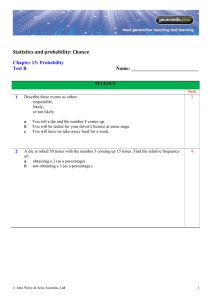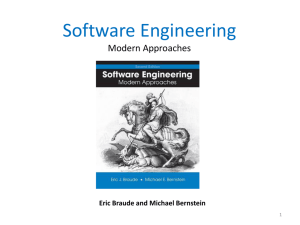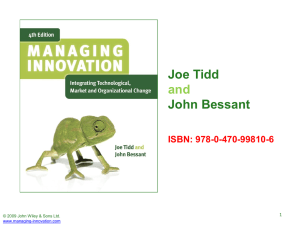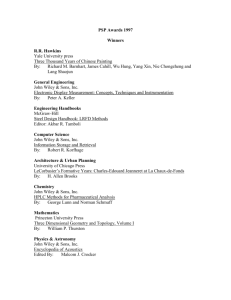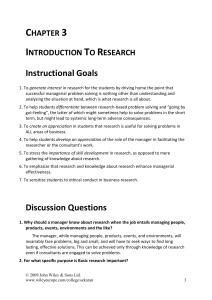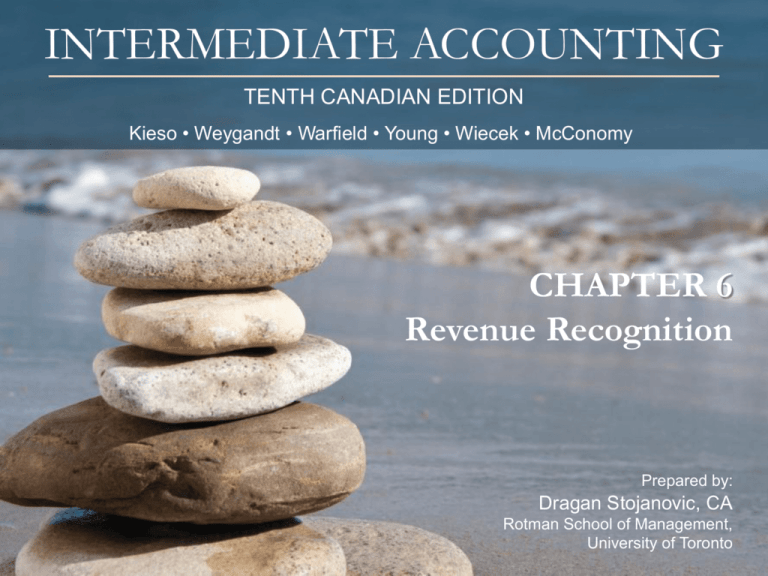
INTERMEDIATE ACCOUNTING
TENTH CANADIAN EDITION
Kieso • Weygandt • Warfield • Young • Wiecek • McConomy
CHAPTER 6
Revenue Recognition
Prepared by:
Dragan Stojanovic, CA
Rotman School of Management,
University of Toronto
CHAPTER 6
Revenue Recognition
After studying this chapter, you should be able to:
•
•
•
•
•
•
•
•
Understand the economics and legalities of selling transactions from a
business perspective.
Analyze and determine whether a company has earned revenues.
Discuss issues relating to measurement and measurement uncertainty.
Understand how to account for sales where there is collection uncertainty.
Prepare journal entries for consignment sales and long-term contracts.
Understand how to present sales transactions in the income statement
and prepare basic disclosures.
Discuss current trends in standard setting for revenue recognition
including the contract-based approach.
Identify differences in accounting between ASPE and IFRS.
Copyright © John Wiley & Sons Canada, Ltd.
2
Revenue Recognition
Understanding the
nature of sales
transactions from a
business
perspective
Recognition and
Measurement
•Economics of
business
transactions
•Legalities
•Information for
decision-making
•Earnings process
Presentation
and
disclosure
•Measurability
•Presentation
•Collectibility
•Disclosure
•Mechanics
Contractbased
revenue
recognition
model
•Core principle
•Five steps
IFRS / ASPE
comparison
•Comparison
of IFRS and
ASP
•Looking
ahead
•Other issues
regarding the
contractbased
approach
Copyright © John Wiley & Sons Canada, Ltd.
3
Understanding Sales Transactions
• Accounting for revenues is often very complex
• Much of complexity is caused by the structure of
the sales transactions
• To properly account for sales transactions,
accountants must understand the business of
the entity and the nature of the transaction
• Key questions for understanding the sales
transactions from a business perspective are:
– What is being given up?
– What is being received?
• Normally specified in sales agreements
Copyright © John Wiley & Sons Canada, Ltd.
4
What is being sold?
• Sales transactions often involve transfer of
goods, services, or both (known as deliverables)
• Accounting is different under each situation
– Sale of goods: physical assets with finite point when
control transfers to buyer (generally with transfer of
legal title and possession)
– Sale of services: legal title and possession irrelevant
– Sale of goods and/or services combinations:
complexity in measuring each component of bundled
sales or multiple deliverables
Copyright © John Wiley & Sons Canada, Ltd.
5
5
What is being received?
• Consideration being received for goods and/or
services sold is either:
– Cash or cash-like (monetary)
– Non-monetary (another good/service, also known as
barter)
• Generally assume that the transaction is at
arm’s length (between unrelated parties) such
that
Value of
Value of
deliverables
consideration
sold
received
=
Copyright © John Wiley & Sons Canada, Ltd.
6
Concessionary Terms
• It is critical to understand if sales are done under
normal terms, or are special/unusual and
contain concessionary terms such as:
–
–
–
–
Lenient return/payment policy
More accommodating credit policy
“Bill and hold” transactions
Inclusion of “extras”
• Concessionary terms may create additional
obligations, or may indicate that control has not
passed to the buyer
Copyright © John Wiley & Sons Canada, Ltd.
7
Legalities
• Rights and obligations of sales transactions are described and
governed by law
• Contract law is most relevant as each sales transaction represents a
contract with the customer
• Contract creates enforceable obligations and establishes the terms
of the deal
• Sales contract generally determines the point when legal title and
possession of goods sold pass on to the customer:
– FOB shipping point
– FOB destination
• Implicit obligations not specifically outlined in the sales contract (i.e.
constructive obligation) may also be enforced under common or
other law
Copyright © John Wiley & Sons Canada, Ltd.
8
Sales Transactions
• Revenue/sales is described as:
– inflow of economic benefits (e.g. Cash,
receivables, etc)
– arising from ordinary activities
• There are two main conceptual views on
how to account for revenues/sales:
– Earnings approach
– Contract-based approach
Copyright © John Wiley & Sons Canada, Ltd.
9
Earnings Approach
• Revenues for the sale of goods are
recognized when the following criteria are
met:
1. Risks and rewards of ownership are
transferred to the buyer
2. Seller has no continuing involvement in, nor
effective control over the sold goods
3. Costs and revenues can be reliably
measured; and
4. Collectibility is probable
Copyright © John Wiley & Sons Canada, Ltd.
10
Earnings Approach – Selling Goods
• Two indicators of whether risk and
rewards transfer from seller to buyer:
– Who has the legal title to the goods sold?
– Who has the possession of the goods sold?
• In some situations, risks and rewards
may be considered to transfer even if
legal title and/or possession don’t pass to
the buyer
– Example: forestry and agricultural products
with assured prices and available markets
Copyright © John Wiley & Sons Canada, Ltd.
11
Earnings Approach - Services and
Long-Term Contracts
• The earnings process for services is
different than for the sale of goods
• For the sale of goods, delivery of the
goods is the generally critical event
• For services, the performance of the
service (which may be on-going or
continuous) is the determination of
revenue recognition
• Recognize revenue at each critical event,
as long as it is collectible
Copyright © John Wiley & Sons Canada, Ltd.
12
Earnings Approach - Services and
Long-Term Contracts
• There are two main ways of accounting for long-term contracts and
other service contracts:
– Percentage-of-Completion Method recognizes revenues and gross profit
each period based on progress or contract completion
– Completed-Contract Method recognizes revenue and gross profit only
after the whole contract is completed
• When performance consists of many ongoing acts (i.e. continuous
earnings process), then percentage-of-completion is preferred, as
long as the company can measure the transaction
• When performance consists of a single act (i.e. discrete earnings
process) or progress cannot be measured, then completed-contract
method may be used
• IFRS makes no mention of completed-contract method and allows
recognition of recoverable revenues equal to costs incurred if
outcome is not reliably measurable (i.e. “zero-profit method”).
Copyright © John Wiley & Sons Canada, Ltd.
13
Measurability
• Sales are generally measured at fair value (reflecting also
time value of money for consideration paid over extended
period of time)
• Measurement uncertainty generally arises when:
– we cannot measure the consideration
– we cannot measure related costs, or
– we cannot measure the outcome of the transaction
• There are two main options for revenue recognition under
measurement uncertainty:
– Do not recognize revenues until measurement uncertainty
resolved
– Recognize revenues but measure and accrue amount relating to
uncertainty as a cost or reduced revenues (preferred)
Copyright © John Wiley & Sons Canada, Ltd.
14
Measuring Parts of a Sale
•
•
•
More complex when sale creates multiple deliverables
(e.g., a product and a service-a telephone company
would sell a phone and a monthly service)
GAAP says to separate each deliverable, if possible
Overall price can be allocated using two methods:
–
–
•
•
Relative fair value method
Residual value method
Timing of recognition for each deliverable is determined
individually with reference to GAAP
If components cannot be measured individually, then
revenue recognition criteria are applied to the bundled
sale as a whole (as if one product/service)
Copyright © John Wiley & Sons Canada, Ltd.
15
Collectibility
• In order to recognize revenues at time of sale, it
is necessary to establish ultimate collectibility
• If collectibility cannot be reasonably assured,
then revenues cannot be recognized at the time
of sale
– Accounting treatment defaults to cash basis (i.e.
recognize income as cash is received)
Copyright © John Wiley & Sons Canada, Ltd.
16
Consignment Sales
• Consignor ships inventory to the consignee
• The consignee acts as an agent to sell the inventory
• Possession has transferred; however legal title
remains with the seller
• Risks and rewards have not transferred
• Goods are held by seller as “Inventory on
Consignment”
• Not held as inventory on consignee’s books
• When merchandise sold, the consignee remits cash
to the consignor (after deducting commission and
other chargeable expenses)
Copyright © John Wiley & Sons Canada, Ltd.
17
Consignment Sales – Earnings
Consignor’s Books
Goods shipped to Consignee
Inventory on Consignment
$$$
Finished Goods Inventory
$$$
Payment of Freight
Inventory on Consignment $$$
Cash
$$$
Notification of Sale
Accounts Receivable
$$$
Relevant Expenses
$$$
Consignment Sales
$$$
Cost of Goods Sold
$$$
Inventory on Consignment
$$$
(Note: cost includes freight)
Receipt of Cash from Sale
Cash
$$$
Accounts Receivable
$$$
Consignee’s Books
No Entry
No Entry
Notification/Payment of Sale
Cash
$$$
Payable to Consignor $$$
Remittance to Consignor
Payable to Consignor $$$
Commission Revenue $$$
Cash
$$$
Copyright © John Wiley & Sons Canada, Ltd.
18
Percentage-of-Completion: Earnings
Approach
• The amount of revenues, costs and gross profit
recognized on long term contracts depends upon the
percentage of work done
• Application of percentage-of-completion method requires
a basis for measuring the progress toward completion at
interim dates, and is based on significant judgement
• Can use input measures (e.g. costs incurred—which is
the most popular method—or labour hours worked)
• Can use output measures (e.g. storeys of a building
completed, tonnes produced)
Copyright © John Wiley & Sons Canada, Ltd.
19
Percentage-of-Completion:
Steps
1
Costs incurred to date
= Percent complete
Most recent estimated total costs
2 Percent complete x Estimated total revenue (or GP) =
Revenue to be recognized to date
3 Revenue (or GP) to be recognized to date –
Revenue (or GP) recognized in prior periods =
Current period revenue (or GP)*
4 *Current period revenue – Current costs = Gross Profit
Copyright © John Wiley & Sons Canada, Ltd.
20
Percentage-of-Completion:
Cost-to-Cost Basis
Data: Contract price: $4,500,000 Estimated cost: $4,000,000
Start date:
July, 2014
Finish: October, 2016
December 31st
Balance sheet date:
Given:
2014
Costs to date
2015
2016
$1,000,000 $2,916,000 $4,050,000
Estimated costs to complete $3,000,000 $1,134,000 $
-0-
Progress billings during year $ 900,000 $2,400,000 $1,200,000
Cash collected during year
$ 750,000 $1,750,000 $2,000,000
Copyright © John Wiley & Sons Canada, Ltd.
21
Percentage-of-Completion:
Cost-to-Cost Basis
Contract Price (a)
Less: Estimated Costs
Costs to Date
Est. Cost to Complete
Est. Total Costs (b)
Estimated Total Gross
Profit (a – b)
Percent Complete
2014
2015
$4,500,000
$4,500,000
$4,500,000
1,000,000
3,000,000
4,000,000
2,916,000
1,134,000
4,050,000
4,050,000
-04,050,000
$ 500,000
$ 450,000
25%
1,000,000
4,000,000
72%
2,916,000
4,050,000
Copyright © John Wiley & Sons Canada, Ltd.
2016
$ 450,000
100%
4,050,000
4,050,000
22
Percentage-of-Completion:
Cost-to-Cost Basis
2014
2015
To record cost of construction:
Construction in Process
1,000,000
Materials, Cash, Payables
1,916,000
1,000,000
1,916,000
To record progress billings:
Accounts Receivable
900,000
Billings on Construction in
Process
2,400,000
900,000
2,400,000
To record collections:
Cash
Accounts Receivable
750,000
1,750,000
750,000
1,750,000
Note: Journal entries for 2016 are not shown due to space limitations
Copyright © John Wiley & Sons Canada, Ltd.
23
Percentage-of-Completion:
Cost-to-Cost Basis
2014
Contract Price (a)
Percent complete (b)
Revenue recognized:
Revenue to date (a x b)
Less: Prior years revenue
Current year revenue
Gross profit recognized:
G.P. to date (Total x %)
Less: G.P. in prior years
Current year G. P.
$4,500,000
25%
2015
$4,500,000
72%
2016
$4,500,000
100%
$1,125,000
-0$1,125,000
$3,240,000
1,125,000
$2,115,000
$4,500,000
3,240,000
$1,260,000
$ 125,000
-0$ 125,000
$ 324,000
125,000
$ 199,000
$ 450,000
324,000
$ 126,000
Copyright © John Wiley & Sons Canada, Ltd.
24
Percentage-of-Completion:
Cost-to-Cost Basis
2014
2015
To recognize revenue and gross profit:
Construction in Process
125,000
199,000
Construction Expenses
1,000,000
1,916,000
Revenue from Long-Term
Contract
1,125,000
2,115,000
To record completion of contract
(recorded on completion date in 2016):
Billings on Construction in
Process
4,500,000
Construction in Process
4,500,000
Note: Some journal entries for 2016 are not shown due to space
limitations
Copyright © John Wiley & Sons Canada, Ltd.
25
Percentage-of-Completion: Financial
Statement Presentation
• The difference between “Construction in
process” and “Billings on construction in
process” is recorded on the Balance
Sheet as either:
– Current asset* (with Inventories) if difference
is a debit balance or
– Current liability* if difference is a credit
balance
*May be non-current depending on length of
contract
Copyright © John Wiley & Sons Canada, Ltd.
26
Percentage-of-Completion: Financial
Statement Presentation
• The balance in the Construction in
Process account represents the costs
incurred + gross profit recognized to date
• The balance in the Billings on Construction
in process represents the billings made to
customers to date
Copyright © John Wiley & Sons Canada, Ltd.
27
Completed-Contract Method: Earnings
Approach
• Revenue and gross profit are recognized on the
completion of the contract
• Advantage: reported revenue is based on actual results,
not estimates
• Disadvantage: does not reflect current performance;
creates distortion of earnings
• All journal entries are the same as the percentage-ofcompletion method except that no entry is recorded at
the end of the period to recognize revenue and gross
profit
• IFRS does not address this method explicitly (unlike
ASPE)
Copyright © John Wiley & Sons Canada, Ltd.
28
Comparison of Results
(Gross Profit Recognition)
Year
2014
Percentage-ofCompletion
CompletedContract
$125,000 $
0
2015
199,000
0
2016
126,000
450,000
Total
$450,000
$450,000
Copyright © John Wiley & Sons Canada, Ltd.
29
Long-Term Contract Losses
•
A long-term contract may produce either:
• an interim loss on a profitable contract or
• an overall loss on unprofitable contract
•
•
Under the percentage-of-completion method,
all losses are immediately recognized
Under the completed-contract method, losses
are recognized only when overall losses result
Copyright © John Wiley & Sons Canada, Ltd.
30
Recognizing Current and Overall
Losses on Long-Term Contracts
Current Loss on
an otherwise
overall profitable
contract
Loss on an
overall unprofitable
contract
Percentage Method:
Recognize loss currently
Completed Method:
No adjustment needed
Percentage Method:
Recognize entire loss now
Completed Method:
Recognize entire loss now
Copyright © John Wiley & Sons Canada, Ltd.
31
Percentage Method: Interim Loss on
Profitable Contract–Example
Data as previously given, except for the 2015 cost estimate
Contract Price
Costs to date
Est. Cost to Complete
Est. Total Costs
Percent Complete
2014
$4,500,000
2015
$4,500,000
2016
$4,500,000
1,000,000
3,000,000
4,000,000
2,916,000
1,468,962
4,384,962
4,384,962
-04,384,962
25%
1,000,000
4,000,000
66.5%
100%
2,916,000
4,384,962
4,384,962
4,384,962
Revenue recognized to date in 2015: $4,500,000 x 66.5% = $2,992,500
Less: Amount recognized in 2014
1,125,000
Revenue recognized in 2015
1,867,500
Less: Actual costs incurred in 2015
1,916,000
Loss recognized in 2015
$48,500
32
Percentage Method: Interim Loss on
Profitable Contract–Example
Record loss for 2015:
Construction Expenses
1,916,000
Construction in Process (loss)
48,500
Revenue from Long-Term Contract
1,867,500
Under the percentage-of completion method the Loss
of $48,500 is reported on the Income Statement in 2015
Under the completed-contract method, no loss
recognized in 2015
Copyright © John Wiley & Sons Canada, Ltd.
33
33
Percentage Method: Interim Loss on
Overall Unprofitable Contract–Example
Data as previously given, except for the 2015 cost estimate
2014
$4,500,000
2015
$4,500,000
2016
$4,500,000 (a)
Costs To Date
Est. Cost to Complete
Est. Total Costs
1,000,000
3,000,000
4,000,000
2,916,000
1,640,250
4,556,250
4,556,250
-04,556,250 (b)
Percent Complete
25%
1,000,000
4,000,000
64%
2,916,000
4,556,250
100%
Gross Loss
(56,250)*
Contract Price
Losses recognized in 2015:
Gross profit recognized in 2014 (needs to be reversed) $125,000
Expected total loss on unprofitable contract (a – b)
*56,250
Total loss to be recognized in 2015
$181,250
Copyright © John Wiley & Sons Canada, Ltd.
34
Percentage Method: Interim Loss on
Overall Unprofitable Contract–Example
Record loss in 2015 for percentage-of-completion method:
Construction Costs expensed in 2015:
Revenue recognizable to date: (4,500,000 X 64%) $2,880,000
Less: Revenue recognized before 2015
1,125,000
Revenue recognized in 2015
1,755,000
Less: Loss recognized in 2015 (see previous slide) 181,250
Construction Cost Expense
1,936,250
Construction Expenses
1,936,250
Construction in Process (Loss)
Revenue from Long-Term Contract
Copyright © John Wiley & Sons Canada, Ltd.
181,250
1,755,000
35
Completed-Contract Method: Interim Loss
on Overall Unprofitable Contract–Example
Record overall loss in 2015 for completed-contract
method:
Loss from Long-Term Contract
56,250
Construction in Process (Loss)
56,250
The loss is recognized in the year it first becomes
evident.
Copyright © John Wiley & Sons Canada, Ltd.
36
Revenues vs. Gains
• Revenues: sales that are part of normal
earnings process (e.g. sale of
manufactured inventory)
• Gains: sales that are not part of the
normal earnings process (e.g. sale of
capital assets used in production of
inventory)
– Gains commonly result from transactions
that do not involve an earnings process, and
so realization is key
Copyright © John Wiley & Sons Canada, Ltd.
37
Reporting Gross vs. Net Revenues
•
•
Revenues can be recorded as the gross
amount billed or as the net amount retained
Consideration should be given to the following
factors:
–
–
–
whether company acts as a principal or as an
agent/broker
whether company takes title to the goods sold
whether company has risks and rewards of
ownership of goods sold
Copyright © John Wiley & Sons Canada, Ltd.
38
Contract-Based Approach
• Proposed by IASB and FASB
• Contract defined as agreement between parties that creates
enforceable rights and obligations
• Standard applies when contract
– has commercial substance
– is approved by both parties
– has identified rights and obligations (including payment terms)
• Standard doesn’t apply to contracts that can be cancelled by either
party at no cost, if
– Goods/services have not been transferred; and
– Payment has not been received and no right to receive payments exists
• Standard proposes increased disclosures
Copyright © John Wiley & Sons Canada, Ltd.
39
Contract-Based Approach
• 5 steps in determining when/how to
recognize revenues:
1. Identify contract
2. Identify separate (enforceable) performance
obligations in contract
3. Determine transaction price
4. Allocate transaction price
5. Recognize revenues when performance
obligation satisfied
Copyright © John Wiley & Sons Canada, Ltd.
40
COPYRIGHT
Copyright © 2013 John Wiley & Sons Canada, Ltd. All
rights reserved. Reproduction or translation of this
work beyond that permitted by Access Copyright (The
Canadian Copyright Licensing Agency) is unlawful.
Requests for further information should be addressed
to the Permissions Department, John Wiley & Sons
Canada, Ltd. The purchaser may make back-up copies
for his or her own use only and not for distribution or
resale. The author and the publisher assume no
responsibility for errors, omissions, or damages caused
by the use of these programs or from the use of the
information contained herein.
Copyright © John Wiley & Sons Canada, Ltd.
41



